
Headphones for music production plays a pivotal role in multimedia projects, particularly for video editors like me. Whether it involves creating soundtracks or refining the audio quality for videos, I have encountered several challenges in achieving the desired sound with my current headphones. While they are excellent for casual listening, they cannot cope with the intricate sound work.
Many of my colleagues in the multimedia field feel the same way. We have concluded that standard consumer headphones fall short when it comes to mixing, mastering, recording, and editing tasks. Consequently, my team and I meticulously tested over 50 headphones for music production, considering such aspects as sound accuracy, comfort, and versatility.
In this guide, we will present our findings, highlight the top headphone selections, and show how they can enhance your music production and audio editing endeavors.
 ★★★★★ (5/5)
★★★★★ (5/5)
The Audio-Technica ATH-M50x is one of the best headphones for music production for excellent sound quality, crisp and balanced mix with deep bass and detailed highs. Besides, its over-ear design ensures a high level of comfort during long audio sessions.
For our investigation, we chose the highest-rated headphones on Amazon for music production. I ensured that the selected headphones offered a flat frequency response, as this is crucial for accurate mixing and sound editing.
Additionally, we wanted comfortable headphones for extended periods of use, ones that are sturdy enough for daily wear, and effective at blocking out noise for improved concentration.
My colleagues at FixThePhoto and I considered headphones across various price points, ranging from $33 to $170, to provide a variety of choices. Moreover, I reviewed user testimonials and expert opinions to guarantee that the headphones we selected would align with different music production styles and setups.
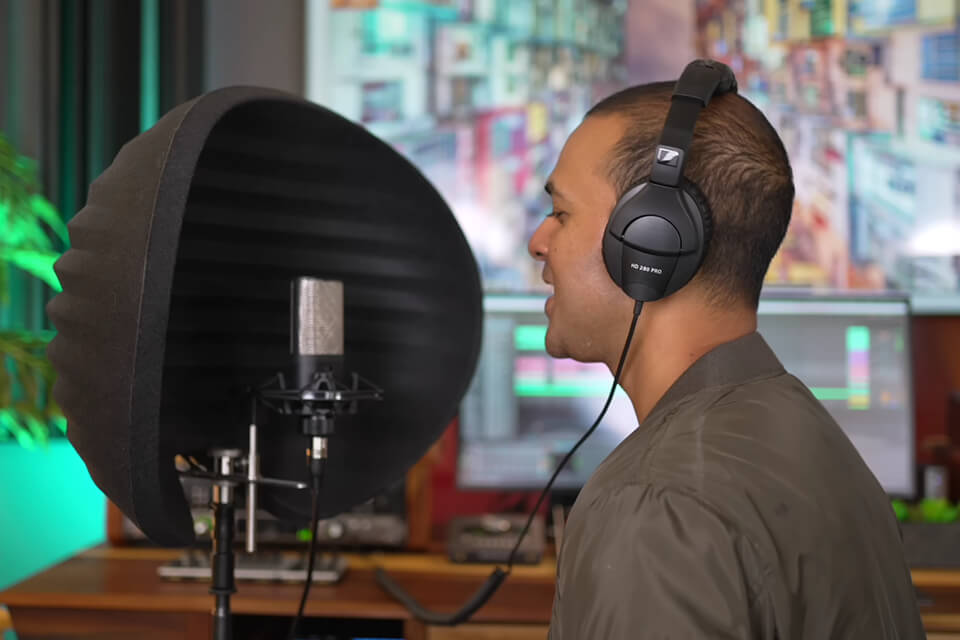
Open-back vs. closed-back design. When you’re in a loud environment, closed-back headphones are ideal. They effectively block out external noises and prevent your music from leaking out. If you’re in a studio setting, open-back ones provide a more authentic sound experience, despite not offering the best noise isolation. Therefore, consider your surroundings when making your choice.
Sound accuracy and clarity. For optimal sound quality, seek headphones that produce a flat, neutral audio profile. This way, you can capture all the subtle details in your mix. Steer clear of headphones that emphasize bass or treble too much, as they can interfere with your mixing process. Look for models that are well-regarded for their precise sound reproduction.
Comfort and fit. Comfort is essential as well! Opt for studio headphones with adjustable headbands, soft ear pads, and an over-ear design. They will be much more comfortable for extended listening sessions. Just ensure they fit comfortably around your ears without being overly constrictive, allowing you to enjoy your music without any distractions.
Durability. When picking headphones for music production, go for well-built ones, like those with metal bands and sturdy earcup designs. Also, check for headphones with replaceable ear pads and detachable cords – they’ll last longer and give you more flexibility!
Impedance and power handling. It is also crucial to check the headphone impedance to see if they’ll work with your audio gear. Headphones with higher impedance (250 ohms) usually need more power but sound much better. Conversely, lower impedance ones (32 ohms) are perfect for most regular devices and don’t need an extra amplifier.
Portability. If you are going to use the headphones for working in both the studio and on the go, portability is an essential aspect to consider. Foldable and lightweight headphones are compact enough and easy to carry around. Models with detachable cables allow for eliminating annoying tangling problems when storing.
Frequency response. Although music production doesn’t demand the widest frequency range, headphones that cover a rich range of frequencies (e.g., 20 Hz to 20 kHz) should be your priority. They will deliver the full range of sound, from deep bass to high-end frequencies.
Swiveling or rotating earcups. If you’re going to do one-ear monitoring while recording vocals or instruments, headphones with swiveling or rotating earcups can be useful. This way, you can easily move the earcup aside without having to remove the headphones from your head.
Amazon: 5K+ bought in the past month
B&H: 40K+ sold in the past year
Adorama: 10K+ sold in the past year
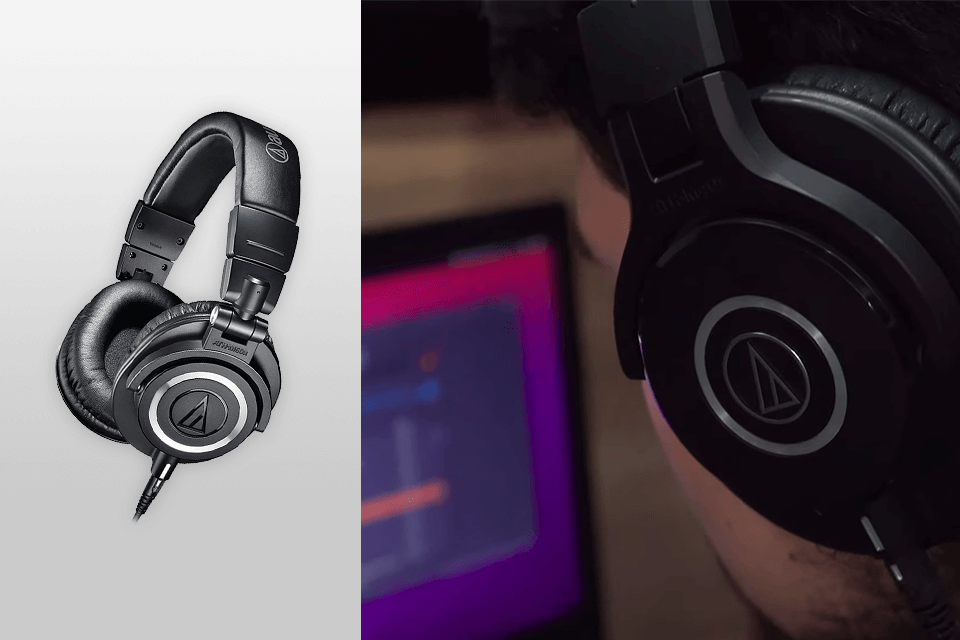
My first experience with Audio-Technica ATH-M50x dates back to 2020. So, I’ve been using these hradphones for video editing for ages, and they’ve always been super reliable. Recently, I decided to give them a shot for music production and see how they handle things in a pro audio setup.
I spent about 6 to 8 hours using the ATH-M50x while making music, including producing a hip-hop track and adding some synthesizers. The soft earpads and adjustable headband provided great comfort for long sessions. Even after four years of frequent use, they still look fantastic, proving their impressive durability.
While working on the bass-heavy sections of my track, I was really impressed with how crisp and impactful the bass sounded – it stayed clear without bleeding into the mids. I could actually pick up on those subtle details, like the faint cymbals and hi-hats, that I couldn’t hear before.
My coworker Anna from FixThePhoto tried out these headphones under 300 dollars for mixing an acoustic track. According to her opinion, the sound was super balanced, which was awesome for bringing out the vocals and instruments. Plus, the earcups that swivel 90 degrees were a game-changer for monitoring with one ear while editing the vocals.
In a team setting, I checked out these music production headphones designed for blocking out sound. They really helped me focus on some tricky sound design tasks. However, my colleague noticed a little sound leaking when I cranked up the volume. On the bright side, the foldable design and detachable cable were super handy while I was testing them out.
| Test | Results | Ratings |
|---|---|---|
|
Comfort
|
Comfortable fit for prolonged use
|
★★★★★
|
|
Audio quality
|
Clear and balanced audio with deep bass, detailed mids, and sharp highs
|
★★★★★
|
|
Sound isolation
|
Superior noise isolation
|
★★★★☆
|
|
Durability
|
Long-lasting materials
|
★★★★★
|
|
Portability
|
Detachable cable and foldable design make them travel-friendly
|
★★★★☆
|
Amazon: 8K+ bought in the past month
B&H: 90K+ sold in the past year
Adorama: 70K+ sold in the past year
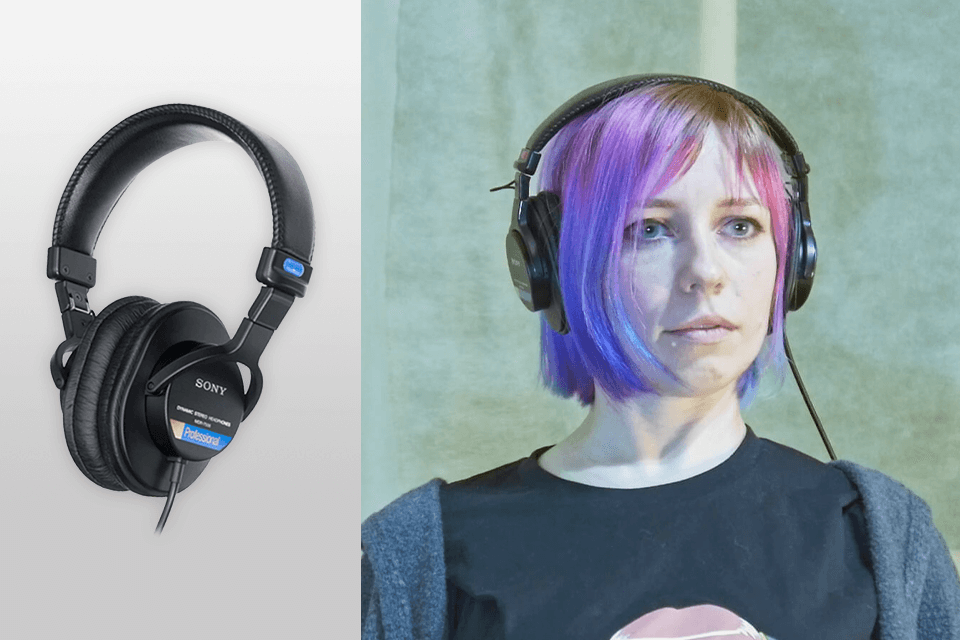
The Sony MDR-7506 is one of the favorite models among aspiring producers and mixing engineers. We tested these closed back headphones for several weeks. Most of the time, I did different tasks on my laptop in a home studio, while other team members checked their performance in a studio with a wide range of professional equipment.
I initially tested the Sony MDR-7506 headphones while working on mixing, editing, and sound design tasks. Since I frequently create electronic music that involves intricate layers, achieving the perfect sound is pivotal. A colleague of mine primarily focuses on post-production of acoustic music.
Flat frequency response is one of their highlights. These headphones do a great job of showing all the sounds clearly, so they’re perfect for catching annoying stuff like clicks, pops, or background noise. Plus, I found that the bass isn’t too overwhelming, which is a nice touch!
My coworker really liked how clear the higher frequencies sounded. When editing acoustic tracks, especially with cymbals and those high-pitched vocals, the high-frequency boost made it easy to catch those little details that you might miss with cheaper models.
I was super impressed with how those recording headphones fit my small head just right. The adjustable headband kept them snug, so they didn’t budge while I was working. My coworker, whose head is bigger, found them comfortable after some adjustments and loved their roomy ear cups.
| Test | Results | Ratings |
|---|---|---|
|
Comfort
|
Nice option for petite head sizes
|
★★★★★
|
|
Audio quality
|
Flat frequency response, good for detecting mix imperfections
|
★★★★☆
|
|
Sound isolation
|
Superior reduction of ambient noise
|
★★★★★
|
|
Durability
|
Rugged construction, durable cord
|
★★★★☆
|
|
Portability
|
Lightweight and foldable, easy to transport
|
★★★★★
|
Amazon: 1K+ bought in the past month
B&H: 10K+ sold in the past year
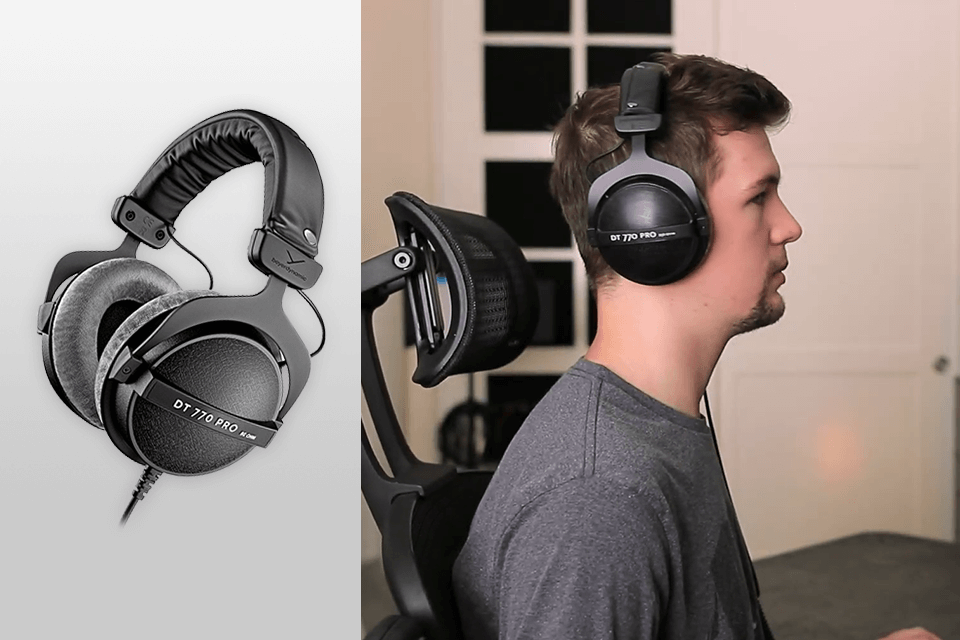
We used the Beyerdynamic DT-770 Pro for about 3 weeks on different music projects. I was mainly mixing and mastering, and my colleague Tani was all about music editing and sound design. We tried them out in our studio, with a Mackie HR824 setup, a Focusrite Scarlett 2i2 interface, and a bunch of audio sources, from simple voiceovers to cool instrumental tracks.
Tani and I were both impressed by how smooth the bass and midrange sounded. There were no oddities or extra elements, even in the low-mid range. We particularly noticed this while mixing tracks that featured powerful kick drums and deep bass synthesizers: everything was remarkably clear, and we could detect all the subtle nuances in the low end.
The treble on the DT-770 Pro is crisp and defined, though some might find it excessively bright. The higher frequencies stand out, enhancing the clarity of percussion and allowing you to notice all the nuances in those elevated sounds. The soundstage is expansive for closed-back headphones, providing a pleasing sense of space and separation even when the mix becomes complex.
The small weight of these studio headphones for music production, which is only 270g, was another great plus for us. Even during long listening sessions, this weight was unnoticeable. Fitted with soft velour ear pads, the headphones are comfortable to wear. Besides, they securely fit because of the adjustable padded headband. These are great headphones for large heads.
Even with the metal parts, it’s super strong, and the 3.0m cable is tough without being a hassle. It was just the right length for us, especially when we were at our desks or working by the equipment racks.
| Test | Results | Ratings |
|---|---|---|
|
Comfort
|
Lightweight, adjustable headband
|
★★★★★
|
|
Audio quality
|
The bass extension is fantastic with clear mids and crisp treble
|
★★★★☆
|
|
Sound isolation
|
The closed-back design effectively blocks out external noise
|
★★★★★
|
|
Durability
|
Solid build with metal components and replaceable ear pads
|
★★★★★
|
|
Portability
|
The headphones are not the most compact for travelers
|
★★★★☆
|
Amazon: 10K+ bought in the past month
B&H: 110K+ sold in the past year
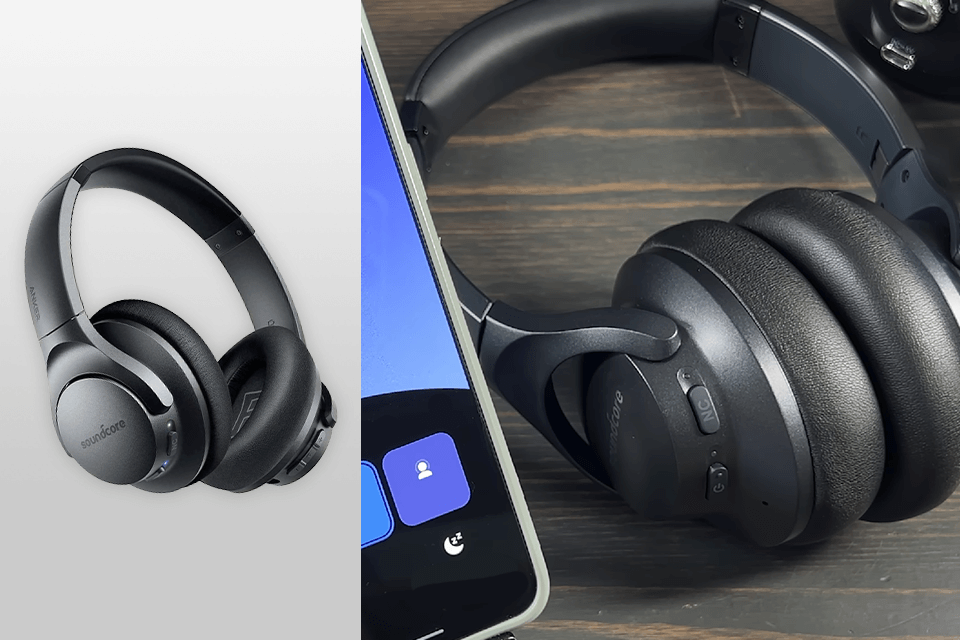
Recently, I had an opportunity to examine the Soundcore Anker Life Q20 headphones for producers. I connected the Soundcore Life Q20 to my MacBook Pro super easily using Bluetooth 5. The controls on the bottom of the ear cups were really user-friendly, and I loved that I didn’t need any fancy app or complicated gestures to use them.
I started by exploring the High-Resolution audio capability since it’s crucial for music production. I played one of my own tracks that features acoustic guitar, vocals, synths, and drums. I wanted to evaluate how distinctly each instrument was represented and how effectively the headphones captured subtle nuances, like the gentle breaths in the vocals and the shimmer of the cymbals.
One of my observations was that the 40mm dynamic drivers produced clear high frequencies extending up to 40kHz, which is beneficial for making accurate adjustments in the mix. The vocals had the perfect level of sibilance without being irritating, and the brilliance from the percussion was highly apparent with absolutely no distortion.
To test this headphone under $50, my colleague played a bass-heavy song featuring a thumping 808 bass line and activated the BassUp mode by double-tapping the play button. The change was incredible: the bass truly stood out and hit powerfully while still allowing the mids and highs to shine through.
The ear cups made of memory foam hugged my ears perfectly and were incredibly comfortable, even after wearing them for over three hours. In addition, the adjustable headband ensured that they remained secure without any trouble. And can we highlight the impressive 60-hour battery life? I used these headphones for several days, and the battery was still going strong!
| Test | Results | Ratings |
|---|---|---|
|
Comfort
|
Memory foam ear cups and adjustable headband
|
★★★★★
|
|
Audio quality
|
Clear highs and punchy bass with BassUp
|
★★★★★
|
|
Sound isolation
|
Effective ANC for low and mid-frequency noise, but less for high-pitched sounds
|
★★★★☆
|
|
Durability
|
Robust build with sturdy materials
|
★★★★☆
|
|
Portability
|
Lightweight, foldable design with a travel pouch for easy storage and transport
|
★★★★★
|
Amazon: 3K+ bought in the past month
B&H: 40K+ sold in the past year
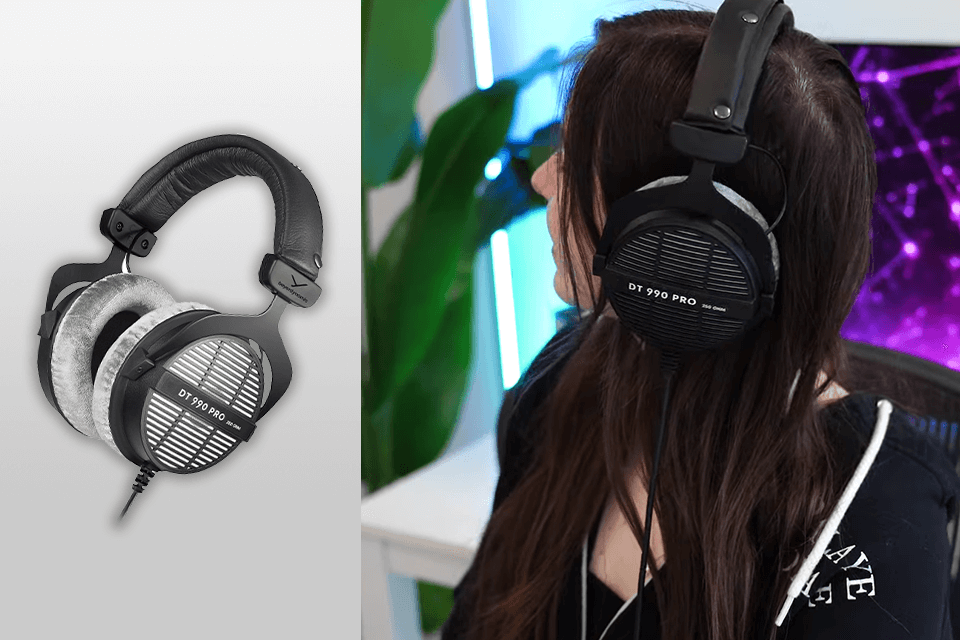
The Beyerdynamic DT 990 PRO are known for their open-back design and expansive sound, making them ideal for mixing and mastering. We tried them in a studio environment, experimenting with different music styles. I focused on electronic music with its complex layers, while my friend worked on some acoustic pieces.
These headphones under 200 dollars stand out among other models because they are extremely comfortable to wear, especially during long listening sessions. Ann from FixThePhoto and I found that they fit perfectly without hurting our ears, even after hours of work.
Upon listening to the first track, it became clear that DT 990 PRO are excellent for music production. They offer an amazing sense of spaciousness and a wide stereo image. The sound is three-dimensional, enabling the listener to pick up on even the tiniest details in the mix. This is ideal for panning, making EQ adjustments, and maintaining spatial awareness during sound design.
Furthermore, the focus isn’t solely on the bass: it is presented with precision, allowing for subtle adjustments without carrying about muddiness in the low end. My colleague, who specializes in voice and acoustic mixes, found that the gentle bass combined with the treble boost effectively emphasized vocal details while preserving the overall sound quality.
| Test | Results | Ratings |
|---|---|---|
|
Comfort
|
The velour ear pads and lightweight design ensured great comfort during extended sessions
|
★★★★★
|
|
Audio quality
|
Awesome sound with crispy low and high tones
|
★★★★☆
|
|
Sound isolation
|
Open-back design allows sound to leak, making them unsuitable for noisy environments
|
★★★☆☆
|
|
Durability
|
Durable construction with a metal U-frame and ear pads that can be easily replaced
|
★★★★☆
|
|
Portability
|
Their big size and open-back design make them less easy to carry around
|
★★☆☆☆
|
Amazon: 3K+ bought in the past month
B&H: 30K+ sold in the past year
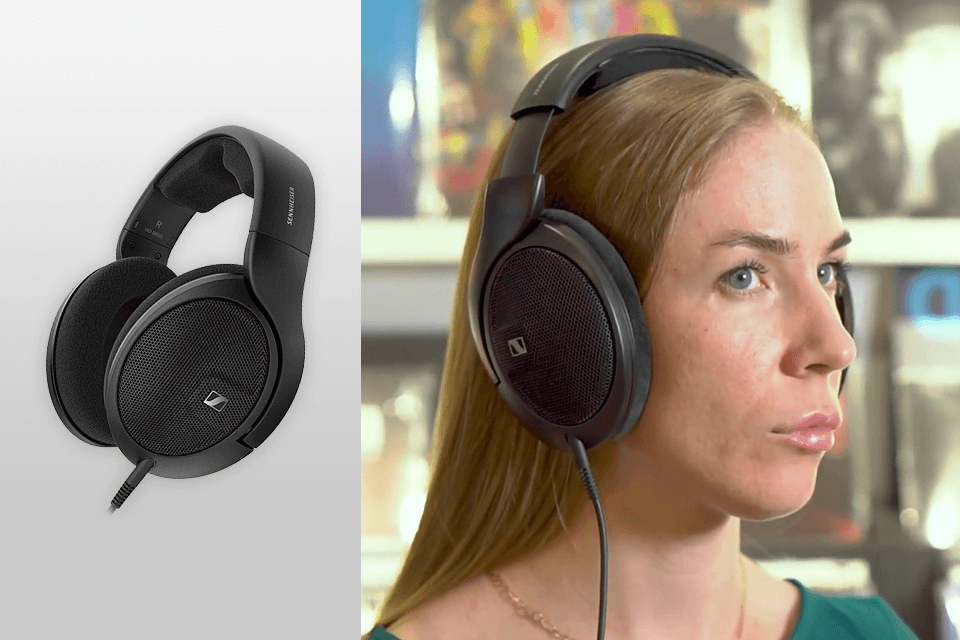
My colleague Kate and I were both impressed by Sennheiser HD 560S after testing them for two weeks. I used the headphones for music production, including electronic music production, track mixing, and listening to various genres. Meanwhile, Kate, who works in sound design and post-production for films, used them for editing sound effects and voiceovers.
From the beginning, we discovered that the Sennheiser HD 560S was extremely comfortable. I wore these headphones for classical music for extended periods, and I was pleasantly surprised by the plush pad covers and soft foam. The large ear cups provided a good fit and distributed the weight evenly. My coworker also shared the same opinion about their comfort.
When using these headphones for mixing music, I found that they were incredibly revealing in a positive way. Whether I was working on a track with subtle atmospheric sounds or a production heavy on synthesizers, I was able to hear every detail with clarity. Kate also noted that they offered a realistic depth and clarity, which aided her in balancing dialogue and background scores.
In my electronic music mixes, the bass stood out as clean and well-controlled. My colleague noted that the accurate low frequencies were perfect for sound effects. The open-back design delivers a more natural sound; however, it fails to effectively block outside noise, making it less ideal for bustling spaces.
| Test | Results | Ratings |
|---|---|---|
|
Comfort
|
Lightweight, plush ear padding
|
★★★★★
|
|
Audio quality
|
Accurate, balanced sound with clear bass and a rich soundstage
|
★★★★☆
|
|
Sound isolation
|
Open-back design that cannot prevent sound leakage
|
★★★☆☆
|
|
Durability
|
Sturdy construction with quality materials, but plastic prevails
|
★★★☆☆
|
|
Portability
|
Wired connection limits mobility, not for on-the-go use
|
★★☆☆☆
|
Amazon: 4K+ bought in the past month
B&H: 50K+ sold in the past year
Adorama: 30K+ sold in the past year
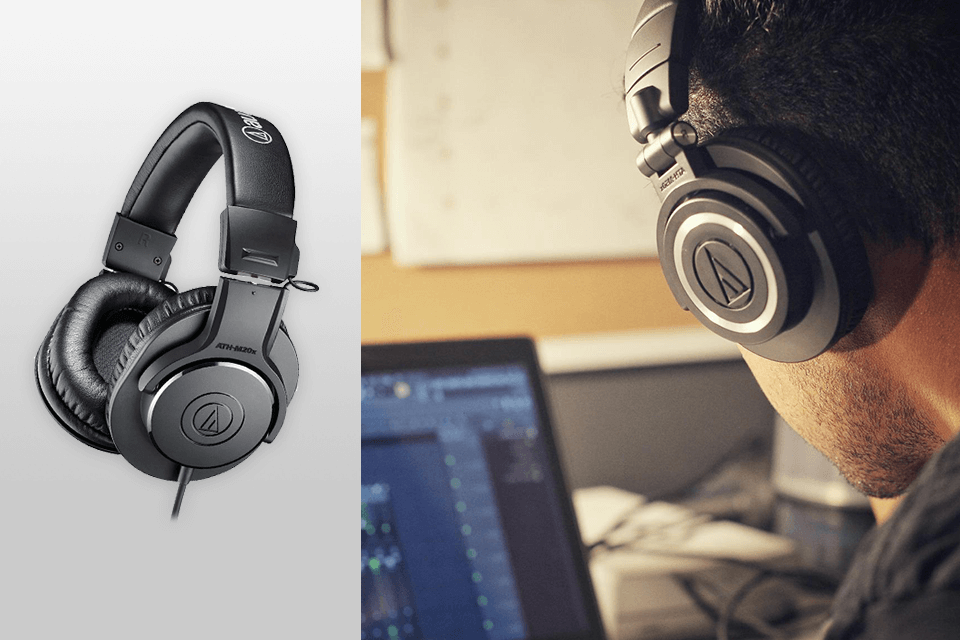
I spent three weeks testing the Audio-Technica ATH-M20X for a client project with FixThePhoto. They fit comfortably on my small head and stay snug even during long periods of use. However, my colleague, who has a larger head, found them to be slightly tight around the ears. This might cause discomfort with prolonged use.
The circumaural design offered excellent isolation, enabling me to concentrate on mixing without being disrupted by outside noise. This was particularly beneficial in a noisy studio when working on vocal tracks.
The 40 mm drivers and rare earth magnets provided exceptional low-frequency sound. They are great for genres with heavy bass. I experimented with “Midnight City” by M83 and “Lose Yourself” by Eminem. The bass had a strong impact and the high notes were crisp. These noise cancelling headphones under $200 managed high-volume mixing without any distortion.
Tani also liked the low-frequency response for bass-heavy music. She noted that the sound isolation was a strong point, especially when recording vocals or other sounds in noisy environments. The single-sided cable exit is a practical feature, which is particularly useful for extended production sessions where the cable is prone to getting tangled.
| Test | Results | Ratings |
|---|---|---|
|
Comfort
|
Comfortable for small heads, tight for larger heads
|
★★★☆☆
|
|
Audio quality
|
Excellent bass, clear highs, and detailed sound
|
★★★★☆
|
|
Sound isolation
|
Great isolation, effective in noisy environments
|
★★★★★
|
|
Durability
|
Solid build quality for the price
|
★★★★☆
|
|
Portability
|
Single-side cable exit, easy to handle
|
★★★★☆
|
Amazon: 10K+ bought in the past month
OneOdio: 100K+ sold in the past year
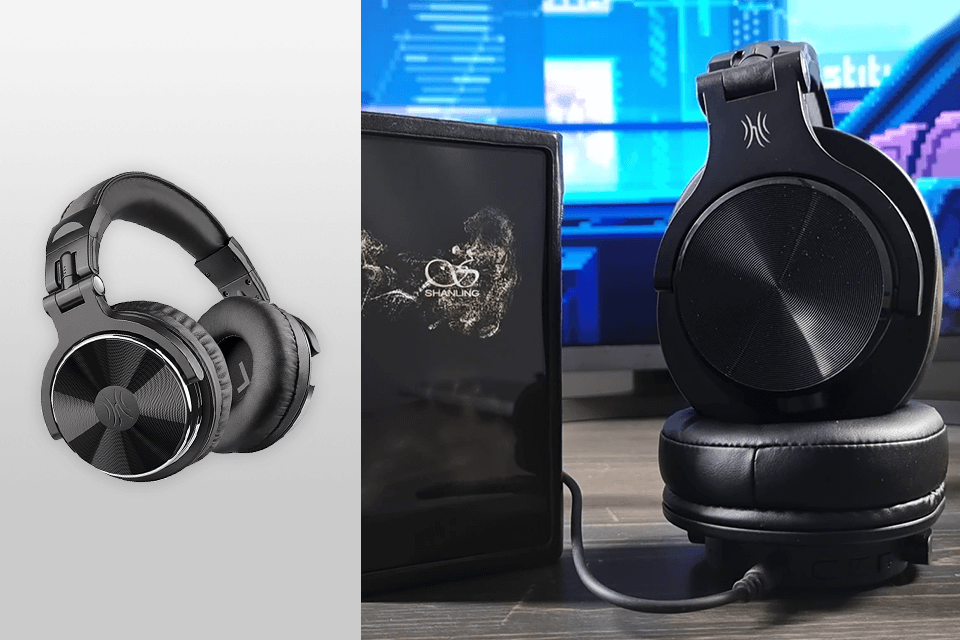
My colleague and I reviewed those OneOdio headphones because of all the Amazon reviews. We tried them out with all sorts of audio, including electronic music, podcasts, voice recordings, and for a film score.
The bass immediately struck us. These headphones boast big 50mm speakers and strong magnets that ensure that your thumping bass is still crystal clear. I tried them out with some heavy bass, and they sounded great. The headphones’ ability to reproduce clear vocals with a solid bass response impressed even my colleague, who mainly works with dialogue.
The comfortable ear cushions are meant for extended use, and the adjustable headband guarantees a secure fit, even after wearing them for ages. We both like the level of comfort it offers. We never experienced any trouble, even during long mixing and recording sessions.
The single-side monitoring ability, enabled by the 90° swiveling ear cups was one of the most versatile features we tested. This is crucial for both music producers and audio engineers. While mixing, I could monitor each side separately and concentrate on the mix elements without any interruptions.
| Test | Results | Ratings |
|---|---|---|
|
Comfort
|
Soft padded ear cushions, adjustable headband for long sessions
|
★★★★★
|
|
Audio quality
|
Powerful bass, clear vocals, balanced mids and highs
|
★★★★☆
|
|
Sound isolation
|
Great but not ideal for very bustling places
|
★★★☆☆
|
|
Durability
|
Sturdy construction, reliable folding mechanism
|
★★★★☆
|
|
Portability
|
Lightweight design, removable cables
|
★★★★★
|
Amazon: 1K+ bought in the past month
B&H: 15K+ sold in the past year
Adorama: 10K+ sold in the past year
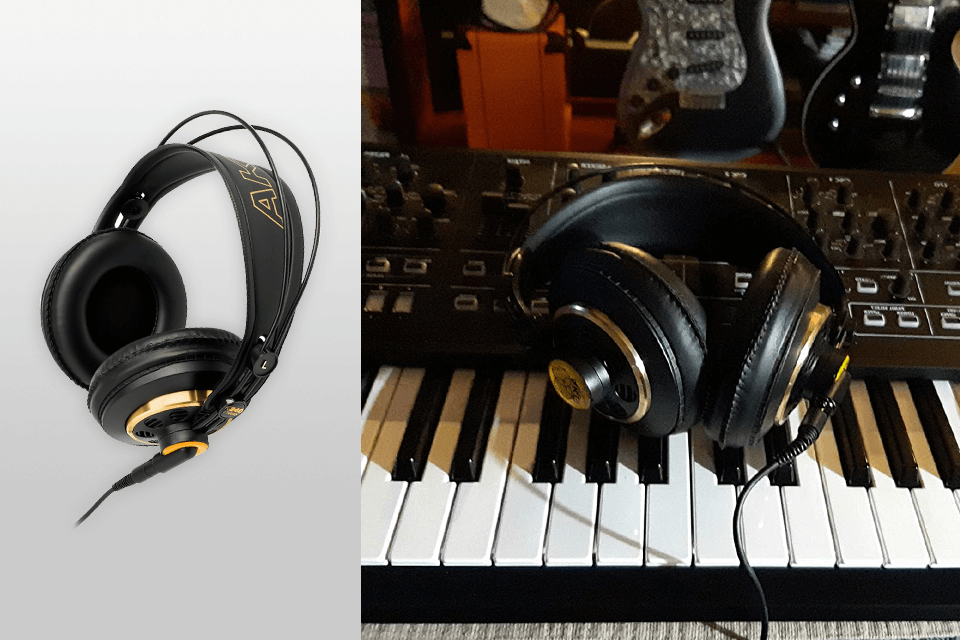
AKG K240 are good headphones for making music as its price is relatively low but their feature set is really impressive. Thanks to the semi-open design and XXL transducers, they are the right fit for different music production scenarios.
To try out these headphones, I’ve produced music wearing them for two weeks. I mainly concentrated on mixing and mastering various genres of music, such as electronic, acoustic folk, and classic rock, using Ableton Live and Logic Pro.
For example, when I was making an electronic track, I could easily separate the high sounds like hi-hats and synths, which let me tweak the mix just right. The acoustic folk song had really nice guitar strums and vocal layers added a real vibe to the sound.
My FixThePhoto colleague mainly used them for podcast editing and classical music mastering. The headphones helped him easily identify subtle pops and background noise, and their accurate and balanced reproduction of the string section in the classical music track was a significant benefit.
The comfort of these headphones for podcasting during prolonged use was another thing we both liked. The ability to adjust the headband and its lightweight design made it easier to enjoy long listening sessions. However, I did experience some discomfort when wearing them with glasses.
| Test | Results | Ratings |
|---|---|---|
|
Comfort
|
Lightweight, self-adjusting headband, discomfort with glasses
|
★★★★☆
|
|
Audio quality
|
Crisp highs, smooth mids, tight bass, wide soundstage
|
★★★★☆
|
|
Sound isolation
|
Limited due to semi-open design, suitable for studio use
|
★★★☆☆
|
|
Durability
|
Withstood heavy use, sturdy construction, replaceable cable
|
★★★★★
|
|
Portability
|
Long cable, semi-open design, which is not suitable mobile use
|
★★★☆☆
|
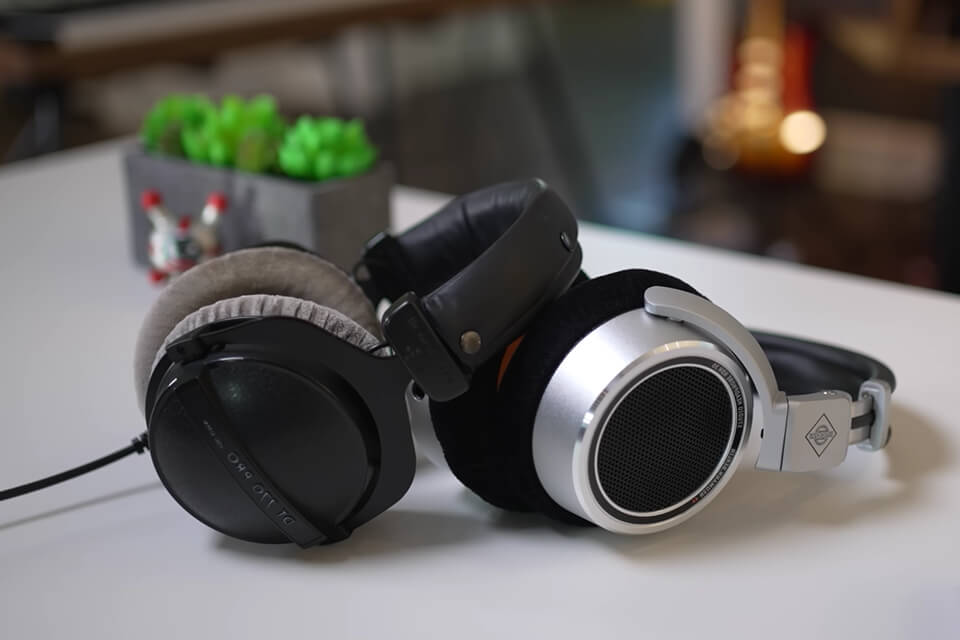
We wanted to make sure our recommendations for the best headphones for music production were accurate and reliable, so we bought all the headphones and thoroughly tested them for several weeks. We wanted to make our music production equipment feel like the real thing for professionals, prioritizing sound quality, comfort, and durability.
We used a mix of reference tracks in different genres, including instrumental, vocal-heavy, and complex soundscapes. This helped us assess how well each pair dealt with the frequency response, clarity, and separation of instruments. We focused on testing the flat, neutral sound profiles of each headphone and observed their performance with both diegetic and non-diegetic sound.
Understanding that lengthy studio sessions require comfortable headphones, we tested each pair for many hours to evaluate their comfort. We looked at the adjustability of the headband, the softness of the ear padding, and the overall weight of the headphones. Comfort played a crucial role, particularly when using them for extended periods during mixing or mastering.
Effective noise isolation is crucial for delivering clear and uninterrupted audio. We evaluated the headphones for music production in both quiet and bustling places to see how effectively they can block out external noises. Furthermore, we played audio at different volume levels to determine if any sound leaked, disrupting others or affecting the overall listening experience.
Music makers use headphones heavily, so we tested every pair by bending, twisting, and adjusting them a lot. We also checked the materials used in the ear cups, headbands, and cables to see if they were good quality. It was very important to make sure the headphones could last a long time in a busy studio.
Finally, we tried each model producing music in real-world scenarios while mixing and mastering tracks, recording, and editing audio. We also checked how well they worked with other equipment, such as audio interfaces and digital audio workstations (DAWs), to make sure they worked well with different setups.